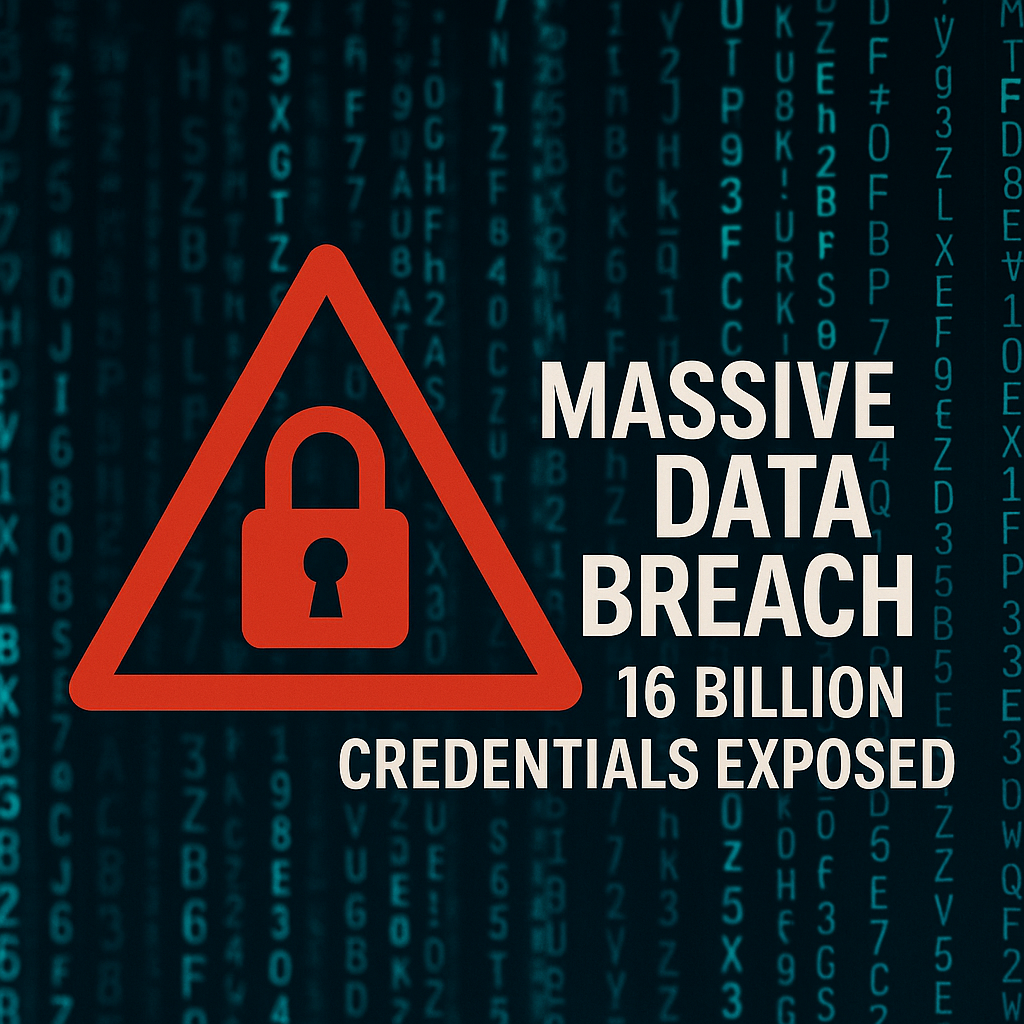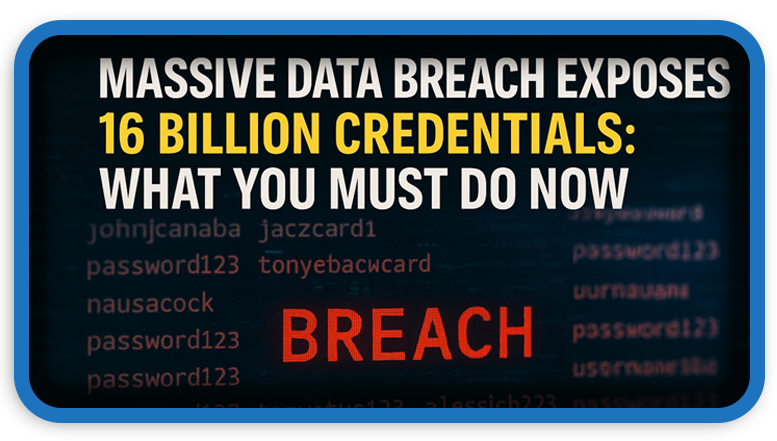⏲️ Estimated reading time: 5 min
🔐 Massive Data Breach Exposes 16 Billion Credentials: What You Must Do Now
🧠 A colossal data breach has compromised over 16 billion login credentials from platforms like Facebook, Google, Apple, GitHub, and even government services. Learn how to protect your accounts and stay safe from identity theft and phishing attacks.
🚨 The Largest Credential Leak in History
Cybersecurity researchers at Cybernews have revealed one of the biggest data breaches ever recorded, involving over 16 billion usernames and passwords. The compromised data spans 30 separate datasets and affects nearly every major digital platform Facebook, Apple, Google, GitHub, Telegram, and various government portals.
This breach is not just a recycled collection of old leaks; most of the data is newly sourced from infostealer malware, making it significantly more dangerous. URLs, email addresses, and login credentials were well-structured for easy cybercriminal access, potentially enabling mass-scale account takeovers, identity theft, and phishing attacks.
🕵️♂️ Where Did the Data Come From?
The massive trove of leaked data was discovered by Cybernews researchers and briefly posted on an open cybercrime forum. The primary source appears to be infostealer malware malicious software designed to infiltrate devices and exfiltrate login credentials and browser-stored data.
Unlike typical breaches caused by single-platform hacks, this incident is a compilation of credentials siphoned from compromised devices globally. Infostealers silently capture data from:
- Web browsers
- Password managers
- Messaging apps
- Crypto wallets
- And more…
The owners of the breach remain unknown, but its sudden appearance and accessibility online make it a blueprint for cybercrime at scale.

🧩 What Makes This Breach So Dangerous?
Here’s why this breach is considered one of the most severe:
- Mostly fresh datasets: Not just older, recycled leaks.
- Highly organized: Easy for hackers to parse and exploit.
- Covers popular and sensitive platforms.
- Not tied to a single entity: Instead, it involves multiple services, increasing attack vectors.
- Unclear user count: Though overlaps exist, the 16 billion figure indicates massive reach.
In short, the potential for exploitation is unprecedented.
🔑 What You Should Do Immediately
1. 🛑 Change Your Passwords
Update your passwords for all online accounts especially your email, banking, social media, and cloud storage. Focus first on:
- Google (Gmail, Drive)
- Facebook & Instagram
- Apple ID
- GitHub
- Telegram
- Government or work-related portals
Use unique passwords for each platform. Avoid reusing the same password across sites.
2. 🔐 Enable Two-Factor Authentication (2FA)
Two-Factor Authentication adds a layer of security by requiring a second verification step. If supported:
- Use authenticator apps like Authy, Google Authenticator, or Microsoft Authenticator.
- Avoid relying on SMS-based codes, as they can be intercepted.
3. 🧠 Use a Password Manager
If you’re not using one already, password managers like:
- 1Password
- Bitwarden
- Dashlane
- NordPass
…can help create strong, random passwords and store them securely.
4. 🔍 Check If You’re Affected
You can use services like:
Enter your email address and see if it appears in any breaches. Some tools also notify you when new breaches occur.
5. 🕵️♀️ Monitor Your Accounts
Keep an eye on:
- Unusual login alerts
- Unknown devices logging into your accounts
- Bank and credit card transactions
- Your inbox for password reset requests you didn’t initiate
Consider using dark web monitoring features offered by services like:
- Norton
- Aura
- Bitdefender
- Experian identity monitoring
6. 🔑 Adopt Passkeys Where Possible
Many platforms now support passkeys a safer, phishing-resistant way to log in. These are:
- Biometric-based
- Device-locked
- Unusable by anyone else
Apple, Google, and Microsoft have begun offering passkey options for major services.
📊 Services Potentially Impacted
The 30 datasets reportedly include user credentials from:
- Facebook / Instagram
- Telegram
- Apple ID
- GitHub
- Microsoft
- Dropbox
- Crypto exchanges
- Government e-portals
- Banking apps
This cross-platform breach implies attackers may now link accounts to create full digital identities, opening the door to:
- Identity fraud
- Financial theft
- Business compromise (especially remote logins)
- Blackmail
🧨 Implications for Businesses and Developers
This breach isn’t just a consumer problem. Developers, especially those using GitHub, CI/CD platforms, or cloud services tied to leaked emails, are at risk of:
- Code repository hijacks
- Credential stuffing attacks
- API key leaks
Teams should immediately:
- Revoke all existing tokens
- Review access logs
- Reset infrastructure passwords
⚠️ Stay Vigilant: This Isn’t Over
According to Forbes, new infostealer-based datasets are emerging regularly, suggesting this is just one wave in an ongoing storm.
The scale and structure of the leak means threat actors may use this data as a blueprint for future cyberattacks, from phishing campaigns to full-scale social engineering schemes.
Final Thoughts
The digital world is becoming increasingly hostile. This breach is a sobering reminder that cybersecurity is no longer optional it’s essential.
🛡️ Act now. Don’t wait until your account is hijacked or your identity is stolen.
🔔For more tutorials like this, consider subscribing to our blog.
📩 Do you have questions or suggestions? Leave a comment or contact us!
🏷️ Tags: data breach, password leak, infostealer malware, 2FA, passkeys, cybernews, Google breach, Facebook leak, identity theft, cybersecurity tips
📢 Hashtags: #DataBreach, #PasswordLeak, #CyberSecurity, #GoogleHack, #FacebookBreach, #Passkeys, #2FA, #Infostealer, #GitHubHack, #DarkWeb
🧩 Digital Shield: Stay Ahead, Stay Safe
Only logged-in users can submit reports.
Discover more from HelpZone
Subscribe to get the latest posts sent to your email.

